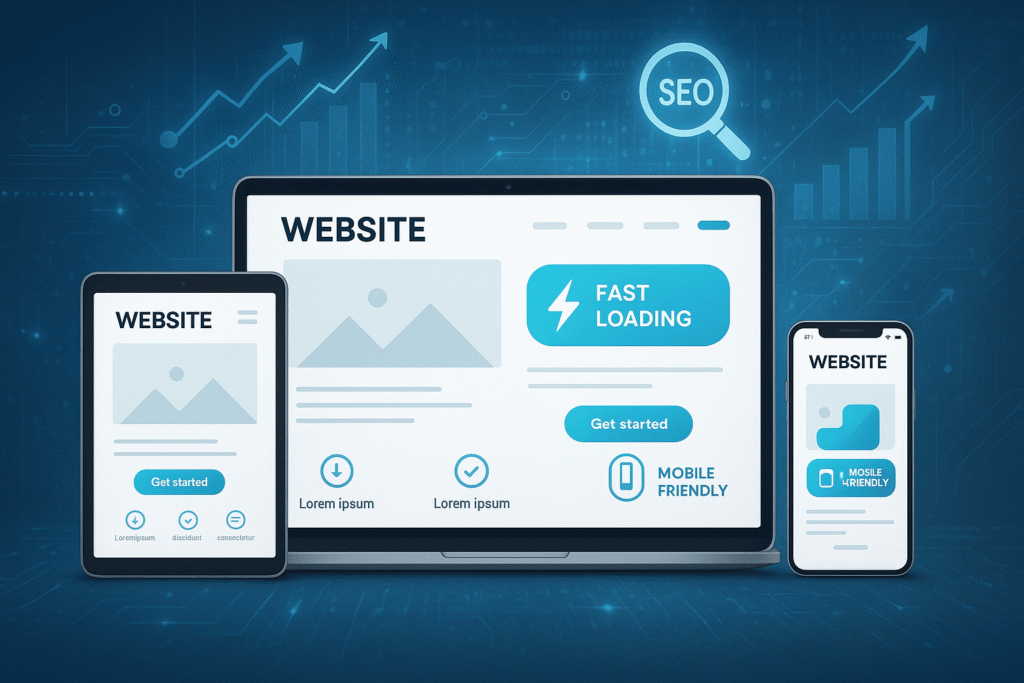Ranking on the first page of Google feels like a victory—and it is. But high rankings don’t always equal high revenue. Many businesses discover this the hard way when their organic traffic increases, but leads and conversions stay flat.
Why? Because SEO can bring users in, but only UX (User Experience) can keep them engaged and move them to act. In today’s competitive digital world, SEO and UX aren’t just complementary—they’re co-dependent.
SEO Brings Visibility, UX Builds Trust
The goal of SEO is to get found. The goal of UX is to make the visit worthwhile.
When someone lands on your site from search, they’re looking for fast answers, smooth navigation, and intuitive design. If your website is clunky, slow, or overwhelming, that user will bounce—even if you’re ranked #1.
SEO gets you the click. UX gets you the conversion.
Core UX Elements That Impact SEO Performance
Google’s algorithm has evolved. It no longer just evaluates your site’s keywords or backlinks—it also looks at how users interact with your pages.
Here’s how UX influences your SEO outcomes:
- Page Speed: A slow site leads to high bounce rates. Google factors in Core Web Vitals like load speed and interactivity.
- Mobile Responsiveness: If your site isn’t optimized for mobile, both Google and users will punish you.
- Navigation and Layout: Confusing menus or cluttered layouts disrupt user flow and reduce dwell time.
- Readability: Clean fonts, proper spacing, and scannable formatting keep visitors engaged longer.
- Call-to-Actions (CTAs): Clear CTAs help turn passive readers into active leads.
A poor user experience signals to search engines that your content may not be satisfying user intent—even if it’s perfectly optimized.
The Problem with SEO-Only Strategies
Many brands still chase rankings without considering what happens after the click. This “SEO tunnel vision” creates websites that:
- Stuff keywords unnaturally
- Prioritize robots over real people
- Lack any emotional appeal or storytelling
- Focus on traffic rather than engagement
The result? High rankings, low conversions, and missed opportunities.
UX Metrics That Reflect SEO Success
Beyond traffic and rankings, there are UX-influenced metrics that help assess real SEO success:
| Metric | What It Tells You |
|---|---|
| Bounce Rate | Whether users find your site relevant |
| Dwell Time | How long users stay and engage |
| Pages per Session | How effectively you guide exploration |
| Conversion Rate | How well your UX turns visits into value |
| Exit Rate | Where users tend to lose interest |
Tracking these metrics helps you balance SEO efforts with UX improvements for better ROI.
Bridging the Gap: SEO Meets UX
To truly grow online, you need to align your content strategy with a frictionless user journey. Here are a few ways to marry the two:
- Content Mapping: Match keyword intent with user expectations. An informational query shouldn’t land users on a product page.
- Design for Intent: If a user is researching, give them value first before pushing a hard CTA.
- Test Everything: A/B test headlines, layouts, CTAs—then iterate.
- Prioritize Accessibility: Design for all users, including those with disabilities.
When SEO gets people to your doorstep and UX invites them in, you create a seamless, high-converting experience.
Final Thoughts
SEO puts your website in the spotlight. But without great UX, that spotlight can quickly burn out. The smartest brands know that ranking is just the start—it’s what happens after that really counts.
Looking to create content that ranks and converts? Work with experts who understand both sides of the equation at https://www.seosets.com.
FAQs
What’s more important—SEO or UX?
Neither is more important than the other—they work together. SEO helps people find your site, while UX ensures they stay, engage, and convert. Focusing on one without the other creates an imbalance that limits growth.
Can a great UX improve my rankings?
Yes. Google uses behavioral signals like bounce rate, dwell time, and page engagement as indirect ranking factors. A smooth, fast, and satisfying UX improves these signals, which can positively impact your SEO performance.
How do I know if my UX is hurting my SEO?
Look for signs like high bounce rates, low time on page, or poor conversion rates despite strong traffic. If people are landing on your site but quickly leaving or not taking action, it’s likely a UX issue.
Should I design my site for Google or for people?
You should design your site for people—but in a way Google can understand. Modern SEO is about aligning with user intent and offering value. If your site satisfies users, Google will notice.
How often should I update my UX or design?
It depends on your data and user feedback. However, a review every 12–18 months is ideal. Monitor performance metrics regularly and update when there are clear signs of friction, drop-offs, or changes in user behavior.


